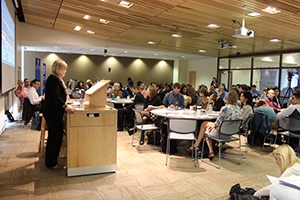Research
New Report Sheds Light on Diversity in Washington, DC

At a time when policing has become a national concern, a new survey shows that fear of the police affects the daily lives of more than half of black and Latino residents in the most racially diverse neighborhoods of metropolitan Washington, D.C. The survey, led by the School of Public Affairs Metropolitan Policy Center, gathered data from more than 1,200 households and includes policy recommendations for lawmakers and community groups.
AU researchers sought residents’ views on policing, crime, health, ethnic relations, trust in local government and business, and neighborhood perceptions. Residents in racially diverse and predominantly Latino neighborhoods were surveyed in both Spanish and English. Survey respondents came from D.C., Montgomery, Prince George’s, Arlington, and Fairfax counties, and the cities of Alexandria, Fairfax City and Falls Church.
The results of the survey were released in a report on October 3. It revealed that black and Latino people were six to seven times more likely than white people to report that fear of arrest or anxiety about police questioning them or their loved ones affected their daily lives.
“Residents of all races are satisfied living in diverse neighborhoods and generally agree about many aspects of life. But the fear of questioning or arrest by the police affects the lives of blacks and Latinos far more than it does the lives of whites or Asians,” said lead author Michael Bader, a sociology professor for the American University College of Arts and Sciences.
Nearly a quarter of Latinos reported that the fear of policy affected their lives “a lot.” Latinos living in predominantly Latino neighborhoods, in particular, reported a strong fear of crime and deportation. Overall, more than a quarter of Latinos reported being afraid to walk alone in their neighborhood after dark for fear of being a victim of violent crime.
Trust was also an issue among respondents. Just under half of residents in diverse neighborhoods surveyed said they trust people in local government to do what is right, while 59 percent said they trusted people in business and 57 percent trusted people in nonprofits. Low-income residents in households earning less than $30,000 a year were twice as likely to those making $150,000 or more to report that nonprofits were not available to meet their needs.
“The varied responses about quality of life by background were somewhat surprising,” says Derek Hyra, School of Public Affairs associate professor and director of its Metropolitan Policy Center. “We know there are a lot of different perceptions and inequities that exist in region across the U.S., but we thought maybe in extremely diverse areas, people would see the world a little more similar. Even within diverse areas, there are social disparities and different perceptions of the same social reality. That’s really important for policymakers to understand.”
Although there is a great sense of racial tolerance, micro-segregation is still occurring in these mixed neighborhoods and the community is viewed through the lenses of the individual residents. Hyra suggests interventions may be needed to ease tension and alleviate some of the perceived inequality the survey found. For instance, decision makers may consider creating services tailored to particular subgroups or offering bilingual programs through nonprofits.
Hyra says Washington, D.C., was a good focus for this research because it is a cosmopolitan, increasingly diverse region that can be a model for high-growth, service-sector areas.
“When we bring people of different races, ethnicities, and incomes into a community setting in the city or suburb, we don’t know a lot about how those communities function or how residents think about one another or their civic institutions,” said Hyra.
With research showing people in mixed neighborhood continue to experience the world differently, policymakers use the information to better inform decisions around gentrification and support development that takes the needs of all residents into account.
Despite the gaps, the survey found that regardless of economic status or racial background, residents are generally satisfied, signaling these neighborhoods will maintain their racial diversity over the long-term.
Plans are currently underway to conduct a second survey to expand the population questioned. For more information, visit the DC Area Survey web page.
